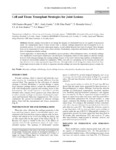Cell and Tissue Transplant Strategies for Joint Lesions

Use this link to cite
http://hdl.handle.net/2183/27915Collections
- Investigación (FCS) [1295]
Metadata
Show full item recordTitle
Cell and Tissue Transplant Strategies for Joint LesionsAuthor(s)
Date
2008-07-11Citation
Fuentes-Boquete IM, Arufe Gonda MC, Díaz Prado SM, Hermida Gómez T, Toro Santos FJ de, Blanco FJ. Cell and Tissue Transplant Strategies for Joint Lesions. Open Transplant J. 2008; 2:21-28
Abstract
[Abstract]
Articular cartilage lesions that do not disrupt the integrity of subchondral bone are not capable of spontaneous repair. The asymptomatic nature of these lesions leads to articular cartilage degeneration and development of the osteoarthritic process. To avoid joint replacement surgery, several cellular therapies have been developed. These therapies focus on the regeneration of a new tissue, whose structure, biochemistry composition and function should be the same as those of endogenous articular cartilage.
Current approaches for interrupting the osteoarthritic process produce a fibrocartilaginous tissue, not articular cartilage. The implantation of autologous chondrocytes and autologous mosaicplasty induces a better quality of articular cartilage; however, both techniques damage the existing cartilage because of the need to harvest large numbers of chondrocytes or to extract an osteochondral cylinder for implantation. While stem cells are a promising tool for repairing articular cartilage, their use is in an early experimental stage at this time. Although studies of cell therapy have shown clinical and functional improvement in joints, the ability to regenerate articular cartilage that resists the degeneration process remains elusive.
Keywords
Articular cartilage
Cell therapy
Focal cartilage lesions
Osteoarthritis
Chondrocyte
Stem cell
Cell therapy
Focal cartilage lesions
Osteoarthritis
Chondrocyte
Stem cell
Editor version
Rights
Atribución 3.0 España
ISSN
1874-4184






